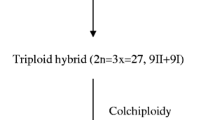Abstract
Analysis of 265 plants derived from 13 sites in the Rokko Mountains shows that the widely distributed eastern AsianEupatorium chinense var.simplicifolium consists of seven cytotypes. These polymorphic karyotypes comprise four levels of ploidy based on X=10 and partial deficiency, occurring either alone or in combination. The polyploid cytotypes exhibit anomalous meiosis and highly variable pollen stainability in contrast to the nearly-normal behaviour of the diploid. The polyploid cytotypes were revealed as being agamospermous. They are readily distinguishable from the diploid cytotypes by several morphological characters and by growth habits closely related to their respective niches. Two or more cytotypes occurred in all sites examined, the most common being the coexistence of triploid and tetraploid cytotypes. The frequencies of occurrence of the pentaploid plants and the cytotypes involving a deficient chromosome were relatively low. While the diploid cytotype is restricted to fragile gravitational slopes and rocky areas which are poor in species and lack tall competitors, the polyploids occur widely in the grasslands, the roadsides or the forest-margins, closely associated with tall grasses and forbs such asMiscanthus sinensis. Based on these data, theE. chinense var.simplicifolium complex is divided into two distinct groups: the diploid cytotype and the polyploid cytotypes.
Similar content being viewed by others
References
Asker, S. 1970. Apomixis and sexuality in thePotentilla argentea complex II. Crosses within the complex. Hereditas66: 189–204.
— 1979. Progress in apomixis research. Hereditas91: 231–240.
Davis, G.L. 1964. Embryological studies in the Compositae. 4. Sporogenesis, gametogenesis and embryogeny inBrachycome ciliaris. Aust. J. Bot.12: 142–151.
Fryar, W.R. 1964. Natural hybridization between two perennial species ofEupatorium (Compositae). M. Sc. Thesis, Florida State University, Tallahassee, Florida.
Gleason, H.A. 1952. The New Britton and Brown Illustrated Flora of the Northeastern United States and Adjacent Canada. New York Bot. Garden, New York.
Grant, W.F. 1953. A cytotaxonomic study in the genusEupatorium. Amer. J. Bot.40: 729–742.
Holmgren, J. 1916. Apogamic in der GattungEupatorium. Svensk Bot. Tid.10: 263–268.
— 1919. Zytologische Studien über die Fortpflanzung bei den GattungenFrigeron undEupatorium. K. Svensk vet. Akad. Handl.59: 1–72.
Hsu, C.C. 1970. Preliminary chromosome studies on the vascular plants of Taiwan (III). The aster family. Compositae. Taiwania15: 17–29.
Huziwara, Y. 1956. Karyotype analysis in some genera of Compositae I. Karyotype of JapaneseEupatorium. Cytologia21: 114–123.
—. 1962. Chromosome studies on some species of Angiospermae I. La Kromosomo53, 54: 1758–1761.
King, R.M. andH. Robinson. 1970.Eupatorium, a Compositae genus of Arcto-Tertiary distribution. Taxon19: 769–774.
—. 1976. Chromosome numbers in Compositae XIII. Eupatorieae. Ann. Missouri Bot. Gard.63: 862–888.
Kitamura, S. 1937. Compositae Japonicae I. Mem. Coll. Sci. Kyoto Imp. Univ. Ser. B.13: 1–421.
— 1957. Compositae Japonicae Pars sexta. Mem. Coll. Sci. Kyoto Univ. Ser. B.24: 1–79.
Lee, Y.N. 1967. Chromosome numbers of flowering plants in Korea (1). J. Korean Cult. Res. Inst.11: 455–478.
Maurushat, H.D. 1969. Natural hybridization in the dog fennels (Eupatorium spp., Compositae). M. Sc. Thesis, Florida State University, Tallahassee.
Montgomery, J.D. andD.E. Fairbrothers. 1970. A biosystematic study of theEupatorium rotundifolium complex (Compositae). Brittonia22: 134–150.
Peng, C.I. andC.C. Hsu. 1978. Chromosome numbers in Taiwan Compositae. Bot. Bull. Academia Sinica19: 53–66.
Richards, A.J. 1970. Eutriploid facultative agamospermy inTaraxacum. New Phytologist69: 761–774.
Skalinska, M. 1971. Experimental and embryological studies inHieracium aurantacum L. Acta Biol. Crac., Ser. Bot.14: 139–152.
—,A. Jankun, H. Wcislo,et al. 1971. Studies in chromosome numbers of Polish Angiosperms. Eighth contribution. Acta Biol. Crac., Ser. Bot.14: 55–102.
Sparvoli, E. 1960a. Osservazioni cito-embriologiche inEupatorium riparium Reg. Nota I. Cariologia. Annali di Bot.24: 120–126.
— 1960b. Osservazioni cito-embriologiche inEupatorium riparium Reg. Nota II. Megasporogenesi e sviuppo del gametofito femminile. Annali di Bot.24: 481–504.
Sullivan, V.I. 1976. Diploidy, polyploidy, and agamospermy among species ofEupatorium (Compositae). Can. J. Bot.54: 2907–2917.
— 1978. Putative hybridization in the genusEupatorium (Compositae). Rhodora80: 513–527.
Turner, B.L. andW.L. Ellison. 1960. Chromosome numbers in the Compositae I. Meiotic chromosome counts for 25 species of Texas Compositae including 6 new generic reports. Texas J. Sci.12: 146–151.
—— andR.M. King. 1961. Chromosome numbers in the Compositae. IV. North American species, with phyletic interpretations. Amer. J. Bot.48: 216–223.
Watanabe, K. 1981. Studies on the control of diploid-like meiosis in polyploid taxa ofChrysanthemum I. HexaploidCh. japonense Nakai. Cytologia46: 459–498.
Author information
Authors and Affiliations
Rights and permissions
About this article
Cite this article
Watanabe, K., Fukuhara, T. & Huziwara, Y. Studies on the Asian Eupatorias. Bot Mag Tokyo 95, 261–280 (1982). https://doi.org/10.1007/BF02488538
Received:
Issue Date:
DOI: https://doi.org/10.1007/BF02488538




